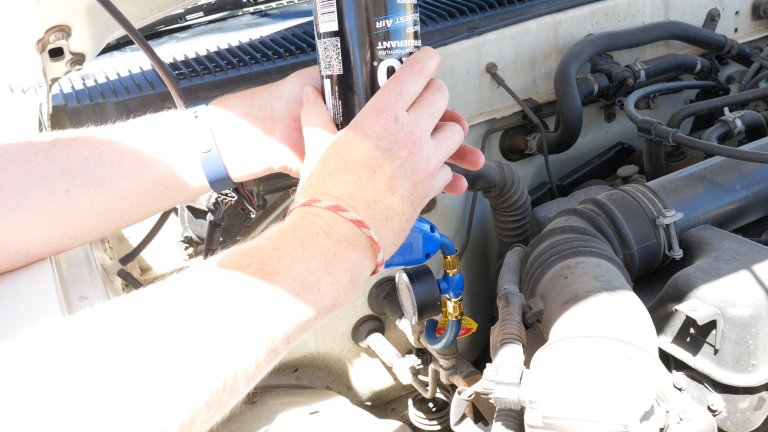1. Turn Your A/C on High for 3-4 Minutes
Put your A/C on all the way cold, recirculating and the highest setting. Let it run for 3-4 minutes at least before proceeding to the next step. This ensures that your system will be attempting to draw the refrigerant through the pipes, which is what we want.
2. Locate Your Low Pressure Service Port
Every vehicle that has air conditioning should also have a high and a low pressure a/c service port. They’re typically aluminum tubes, one thicker and one thinner. They also have removable caps on them labeled with an ‘H’ and an ‘L’ respectively. Locate the low pressure service port and remove the cap. It should either thread off or just pop off. Be sure to put it somewhere safe.
3. Use the A/C Gauge to Determine Your Current Pressure
The refrigerant you purchased should have come with a pressure gauge. The adapter on the end is identical to that of an air compressor hose. Pull up the collet and attach the adapter to the low pressure port. You should get a reading on your gauge. If you’re pretty much out of refrigerant, or very low, you’ll likely get a reading between 0 and 15 PSI. That means it’s definitely time for a recharge. If, however, your reading is in the blue zone (typically above 30 PSI) you might not need refrigerant and may have a different issue altogether. Be aware that over filling your refrigerant can be harmful to your system and may cause the same lack of cold air as an under-pressured system.
4. Shake it up!
Once you’ve determined that you need more refrigerant, start shaking the can. Its contents need to be well agitated to mix up the settled contents. Keep shaking throughout the next steps as well.
5. Fill It to the Appropriate Level
Check the included chart to determine what PSI you need to be at, which is determined by the outside/surrounding temperature. If you’re in a room temperature garage, for example (70 deg. F), then you’ll need your low pressure to be at 35-40 PSI. If it’s 100 degrees out, you’ll need to be up at 50-55 PSI. Keep moving the can horizontally and vertically as you squeeze the trigger to pressurize the system. Be sure to stop from time to time to check the pressure level so as to not over-fill it.

That’s it! You should have functioning A/C again – woohoo! If you’ve been without it on a scorching hot day and then get it fixed, you know what a joyous occasion this can be. In this case, I was working on my Dad’s old truck and he actually has never had A/C in it since he bought it a couple of years ago so you can imagine how pleased he was to feel the ice-cold air blowing out of the vents. Summers are suddenly much more bearable!
A Few Tips
- The symptoms for low refrigerant pressure are varied and can include:
- Warm Air coming out of the vents when the A/C is on
- Cool air but not as cold as it should be
- A/C only working on one side of the vehicle or certain vents
- Pressing the A/C button doesn’t seem to have any impact on the air temperature
- If there’s a bit of refrigerant still left in the can, you cannot remove the nozzle and use the can again. You must use it all in one shot, or at least without disconnecting the hose, or else the remainder of the refrigerant will leak out.
- The hose and gauge of the refrigerant can be reused. The hose and gauge seen in this video is the one I bought for my car and then used on my Dad’s car, so he just has to buy the bottle, not the bottle, hose and gauge.
Happy recharging!
Ready to watch the video to see it in action? Check it out.

